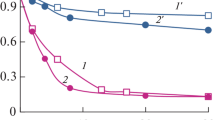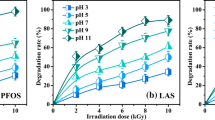Abstract
In this study the treatment efficiency of different ultraviolet (UV)-enhanced ozonation processes for degradation of two surfactants, sodium dodecylbenzene sulfonate [200 mg/L or 0.3 critical micelle concentration (CMC)] and a nonylphenol ethoxylate with 40 oxyethylene units (200 mg/L ~0.5 CMC), were investigated in laboratory-scale experiments at ambient temperature. The absorbance band of the aromatic ring of the surfactants was monitored during the oxidation process. The reduction in chemical oxygen demand (COD) and total organic carbon (TOC) of the surfactant solution was evaluated. The results showed that a combination of UV irradiation and ozonation was considerably more efficient than the individual processes (at least two times more efficient in terms of COD and TOC reductions). The synergistic effect of ozonation and UV irradiation was particularly pronounced when medium-pressure UV irradiation was used. By adding alkali to the solution, the efficiency of the UV-enhanced ozonation increased with respect to COD reduction but decreased with respect to TOC reduction. This indicates partial oxidation with lower degree of mineralization of the surfactants.


Similar content being viewed by others
References
Hargreaves T (2003) Surfactants: the ubiquitous amphiphiles, chemistry world, RSC
Huber L, Nitschke L (eds) (2002) Environmental aspects of surfactants. Wiley, Chichester
Cserháti T, Forgács E, Oros G, Cserháti T (2002) Biological activity and environmental impact of anionic surfactants. Environ Int 28:337–348
Vandevivere PC, Bianchi R, Verstraete W (1998) Treatment and reuse of wastewater from the textile wet-processing industry: review of emerging technologies. J Chem Technol Biotechnol 72:289–302
Scott MJ, Jones MN (2000) The biodegradation of surfactants in the environment. Biochim Biophys Acta Biomembr 1508:235–251
Kitis M, Adams CD, Kuzhikannil J, Daigger GT (2000) Effects of ozone/hydrogen peroxide pretreatment on aerobic biodegradability of nonionic surfactants and polypropylene glycol. Environ Sci Technol 34:2305–2310
Beltran FJ, Garcia-Araya JF, Alvarez PM (2000) Sodium dodecylbenzenesulfonate removal from water and wastewater. 2. Kinetics of the integrated ozone-activated sludge system. Ind Eng Chem Res 39:2221–2227
Berna JL (2006) Comments on: removal of the surfactant sodium dodecylbenzene sulphonate from water by simultaneous use of ozone and activated carbon. Water Res 40:1717–1725
Brambilla AM, Calvosa L, Monteverdi A, Polesello S, Rindone B (1993) Ozone oxidation of polyethoxylated alcohols. Water Res 27:1313–1322
Calvosa L, Monteverdi A, Rindone B, Riva G (1991) Ozone oxidation of compounds resistant to biological degradation. Water Res 25:985–993
Vilve M, Hirvonen A, Sillanpää M (2007) Ozone-based advanced oxidation processes in nuclear laundry water treatment. Env Technol 28:961–968
Narkis N, Schneider-Rote M (1980) Ozone-induced biodegradability of a non-ionic surfactant. Water Res 14:1225–1232
Banerjee P, Chatterjee S, Pramanik S, Bhattacharya SC (2007) Interaction of Pyrene-1-Carboxaldehyde with micelles and mixed micelles of polyoxyethylene nonyl phenol (Igepal): a spectroscopic study. Colloids Surf A 302:44–50
Paria S, Yuet PK (2006) Solubilization of naphthalene by pure and mixed surfactants. Ind Eng Chem Res 45:3552–3558
Yang K, Zhu L, Xing B (2006) Enhanced soil washing of phenanthrene by mixed solutions of TX100 and SDBS. Environ Sci Technol 40:4274–4280
Om H, Baker GA, Behera K, Kuma V, Verma KK, Pandey S (2010) Self-probing of micellization within phenyl-containing surfactant solutions. Chem Phys Chem 11:2510–2513
Peternel I, Koprivanac N, Kusic H (2006) UV-based processes for reactive azo dye mineralization. Water Res 40:525–532
Nicole I, Laat JD, Dore M, Duguet JP, Bonnel C (1990) Use of UV radiation in water treatment: measurement of photonic flux by hydrogen peroxide actinometry. Water Res 24:157–168
Kuo WG (1992) Decolorization dye wastewater with Fenton’s reagent. Water Res 26:881–886
American Public Health Association APHA (1992) Standard methods for the examination of water and wastewater, 17th edn. APHA, Washington
Bowers AR, Cho SH, Singh A (1992) Chemical oxidation of aromatic compounds: comparison of H2O2, KMnO4, and O3 for toxicity reduction and improvements in biodegradability. In: Wesley-Eckenfelder W, Bowers AR, Roth JA (eds) Chemical oxidation: technologies for nineties. Technomic, Lanchester
Vogel F, Harf J, Hug A, Rudolf-von-Rohr P (2000) The mean oxidation number of carbon (MOC)—a useful concept for describing oxidation processes. Water Res 34:2689–2702
Narkis N, Schneider-Rotel M (1980) Ozone-induced biodegradability of a non-ionic surfactant. Water Res 14:1225–1232
Alvares ABC, Diaper C, Parsons SA (2001) Partial oxidation by ozone to remove recalcitrance from wastewaters—a review. Environ Technol 22:409–427
Beltran FJ (2004) Ozone reaction kinetics for water and wastewater systems. Levis, CRC imprint, Florida
Ledakowicz S, Miller JS, Olejnik D (2001) Oxidation of PAHs in water solution by ozone combined with ultraviolet radiation. Int J Photoenergy 3:95–101
Gottschalk C, Libra JA, Saupe A (2002) Ozonation of water and waste water. Wiley-VCH, Weinheim
Lopes-de-Morais J, Peralta-Zamora P (2005) Use of advanced oxidation processes to improve the biodegradability of mature landfill leachates. J Hazard Mater 123:181–186
Acknowledgments
We are grateful to Mr. M. Deihimi and Mr. H. Heidari for helping the research team. This research was supported by the International Foundation for Science, Stockholm, Sweden.
Author information
Authors and Affiliations
Corresponding author
Electronic supplementary material
Below is the link to the electronic supplementary material.
About this article
Cite this article
Tehrani-Bagha, A.R., Nikkar, H., Menger, F.M. et al. Degradation of Two Persistent Surfactants by UV-Enhanced Ozonation. J Surfact Deterg 15, 59–66 (2012). https://doi.org/10.1007/s11743-011-1271-6
Received:
Accepted:
Published:
Issue Date:
DOI: https://doi.org/10.1007/s11743-011-1271-6




